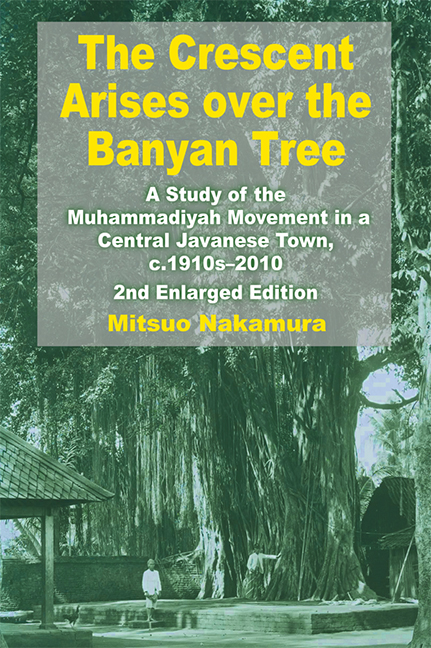 The Crescent Arises over the Banyan Tree
The Crescent Arises over the Banyan Tree Book contents
- Frontmatter
- Dedication
- Epigraph
- Contents
- List of Figures and Maps
- List of Tables
- List of Boxes
- Foreword to the Second Edition
- Preface to the Second Edition
- Foreword to the First Edition
- Preface to the First Edition
- Notes
- Map
- PART I DEVELOPMENT OF THE MUHAMMADIYAH IN KOTAGEDE, c.1910s–1972
- PART II KOTAGEDE REVISITED, 1972–2010
- Epigraph
- Map
- Introduction to Part II
- 8 Social Changes in Kotagede, 1972–2010
- 9 The Achievements of the Muhammadiyah
- 10 Internal Dynamics of the Muhammadiyah Movement
- 11 Challenges Facing the Muhammadiyah
- 12 Festival Kotagede: Conflict and Integration
- 13 The May 2006 Earthquake and Reconstruction of Kotagede
- 14 Concluding Remarks: Future of the Muhammadiyah
- Postscript to Part II
- Bibliography
- Glossary
- Appendices
- Index
- About the Author
Postscript to Part II
from PART II - KOTAGEDE REVISITED, 1972–2010
Published online by Cambridge University Press: 21 October 2015
- Frontmatter
- Dedication
- Epigraph
- Contents
- List of Figures and Maps
- List of Tables
- List of Boxes
- Foreword to the Second Edition
- Preface to the Second Edition
- Foreword to the First Edition
- Preface to the First Edition
- Notes
- Map
- PART I DEVELOPMENT OF THE MUHAMMADIYAH IN KOTAGEDE, c.1910s–1972
- PART II KOTAGEDE REVISITED, 1972–2010
- Epigraph
- Map
- Introduction to Part II
- 8 Social Changes in Kotagede, 1972–2010
- 9 The Achievements of the Muhammadiyah
- 10 Internal Dynamics of the Muhammadiyah Movement
- 11 Challenges Facing the Muhammadiyah
- 12 Festival Kotagede: Conflict and Integration
- 13 The May 2006 Earthquake and Reconstruction of Kotagede
- 14 Concluding Remarks: Future of the Muhammadiyah
- Postscript to Part II
- Bibliography
- Glossary
- Appendices
- Index
- About the Author
Summary
Here I would like to indulge in a bit of personal reminiscences to put my original work into perspective. I shall be doing so by acknowledging the help of several individuals who assisted or encouraged me in writing my dissertation and the subsequent “Banyan Tree” book in various ways. I would also like to thank those people who have helped me to undertake a brief but fruitful fieldwork for revisiting Kotagede, December 2008 to February 2009.
My initial as well as official research topic before visiting Indonesia for the first time was on the social history of indigenous Javanese urban society. I intended to replicate and test Clifford Geertz's work on the social history of a Javanese town of “Modjokuto” in a more appropriate location. I felt that Geertz's “Modjokuto” was too shallow in its history and marginal to the centre of Javanese civilization. The town of Pare, which is the real name of “Modjokuto”, was in fact a young frontier town just emerged since the mid-nineteenth century, thanks to the growth of sugar and tobacco cultivation. It was inappropriate, according to my view, to be taken as a sample for representing the traditional urban ways of Javanese life. I was planning to conduct fieldwork in Kotagede and Klaten, following Professor Selosoemardjan's suggestion, to compare “old and new” urban communities in inner Central Java.
Kotagede was thought to be a natural choice to study traditional urbanism in Java. The town appeared in history as the initial capital of the Islamized Mataram Kingdom in the late sixteenth century and has continued to maintain its physical and cultural identity until the modern times. The town was much older than Yogyakarta and Surakarta, the capitals of the two principalities tracing their history back to 1755 when the Mataram Kingdom split into two, and then four. Meanwhile, Klaten was somewhat comparable to “Modjokuto” as a new frontier town, developed with the imposition of the Culture System by the Dutch authorities in rural Central Java. However, I had to abandon the plan to do fieldwork in Klaten in the end because the data gathering in Kotagede consumed the entire time (and funds) allowed for me.
- Type
- Chapter
- Information
- The Crescent Arises over the Banyan TreeA Study of the Muhammadiyah Movement in a Central Javanese Town, c.1910s-2010 (Second Enlarged Edition), pp. 372 - 380Publisher: ISEAS–Yusof Ishak InstitutePrint publication year: 2012


